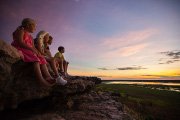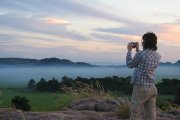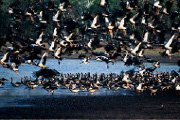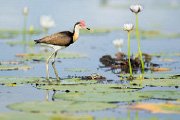Landscapes
Kakadu is a place of enormous biological diversity. Within the vast landscapes, there are six main landforms— Savannah woodlands, southern hills and ridges, stone country, tidal flats and coast, the wetlands and the outliers.
Within each landform live a range of plants and animals, endemic to Kakadu.
Savanna woodlands
The savanna woodlands, sometimes referred to as the lowlands, make up nearly 80 per cent of Kakadu. They consist mostly of eucalypts and tall grasses and support a greater variety of plants and animals than any other habitat in Kakadu.
Wildlife of savanna woodlands
At first glance, there appears to be little activity in the lowlands, yet they are in fact the richest of all Kakadu's habitats in terms of animal numbers. They contain a wealth of bird life, especially along the watercourses.
Prominent in the lowlands are the termite mounds. Inside each mound is an intricate network of tunnels and chambers that serve as highways to food and water, as areas for storing food, and as nurseries. Over 55 species of termites occur in the park, although not all of them build mounds. Some live in and on trees, some live completely underground. Wood-eating termites hollow out tree limbs and so provide homes for many other lowland birds, mammals, reptiles and amphibians.
Plants of the savanna woodlands
The greater part of Kakadu is covered by eucalypt-dominated open forest and woodland. These tracts are among the last expanses of virgin eucalypt forest in Australia. The lowland plants are heavily influenced by seasonal factors. The wet season is a period of growth, when plants make the most of the abundant water. The dry season is a more stressful time, and the plants have a variety of mechanisms for coping with this long waterless period.
Open forest is dominated by the Darwin stringybark, Darwin woollybutt and Cooktown ironwood. Woodlands contain many types of eucalypts, including bloodwoods and boxes. The understorey of both open forest and woodland is generally made up of smaller trees such as pandanus and green plums, shrubs, and tall grasses such as spear grass. The greatest species diversity occurs, however, in the ground layer, where there is a large range of grasses, sedges and wildflowers.
Southern hills and basins
The southern hills and ridges cover a large area in the south of the park, including the headwaters of the South Alligator River. Here rocks have been exposed from beneath the retreating Arnhem escarpment. They are volcanic and extremely old (2500 million years). These landforms create a unique and diverse habitats and the plants and animals that live here do not occur anywhere else.
This landform is characterised by rugged strike ridges separated by alluvial flats. Its features can be easily observed from the top of Gunlom Falls and on the Yurmikmik walking tracks.
Wildlife of the southern hills and basins
In the South Alligator valley there is a juncture of two biogeographical systems. There is the Arnhem Land plateau and the Marrawal plateau (which extends towards Katherine Gorge). They create a large variety of habitats which support significant numbers of uncommon or endemic species.
Among the animals that are harder to spot are the brightly coloured hooded parrot, the endangered Gouldian finch, the vulnerable red goshawk, and nocturnal animals such as Calaby's mouse and the Kakadu dunnart. The more commonly sighted animals are the black-breasted buzzard (a kite that is easily identified because of the white 'bulls-eyes' in its wings) and the antilopine wallaby (often confused with the red kangaroo).
Plants of the southern hills and ridges
The habitats of the southern hills and basins support several endemic plants (plants not found anywhere else in the world). One example is the untidy Eucalyptus koolpinensis (Koolpin box). There are only two known populations near Jarrangbarnmi (Koolpin Gorge).
Stone Country
The dominant sandstone escarpment of the Arnhem Land Plateau ranges in height from 30 metres to 300 metres, and includes the rock shelters and outliers of Ubirr and Nourlangie. In some areas the escarpment is eroding by up to one metre every thousand years.
It is believed that 140 million years ago much of Kakadu was under a shallow sea. The prominent escarpment wall formed sea cliffs and the Arnhem Land plateau formed a flat land above the sea. Today the escarpment, which rises to 330 metres above the plains, extends over 500 kilometres along the eastern boundary of the park. It varies from vertical cliffs in the Jim Jim Falls area to stepped cliffs and isolated outliers in the north.
The rock platforms of the plateau are dissected by a network of chasms and gorges. The top of the plateau is a harsh, dry place. Water drains away quickly. In most areas soil is scarce. The small patches of soil that are to be found consist mostly of coarse sand and leaf litter trapped in rock fissures or shallow depressions. Sparsely distributed pockets of woodland and open forest have developed on these coarse soils.
Along the escarpment, creeks have etched deep incisions to form gorges in which tall monsoon forests have developed. Water seeping from rock walls and the deep alluvial soils provide an important micro-environment for plants and animals. Many animals rely on these areas for refuge during the drier months. The dominant plant species is Allosyncarpia ternata, a large, spreading, shady tree that is found only in the Kakadu and Arnhem Land region.
Wildlife of the Stone Country
Among the endemic animals that can readily be seen at Ubirr and Nourlangie are the chestnut-quilled rock pigeon and the black wallaroo (the male black wallaroo is dark brown to black while the female is grey).
Freshwater crocodiles live across the top end of Australia in the upper reaches of the larger rivers and creeks. They nest in the late dry season (September and October) along sandy banks, where they lay their eggs in carefully dug holes and then cover them.
Other stone country species are the peregrine falcon, the ghost bat, the short-eared rock wallaby (often seen at Ubirr) and Merten's water monitor.
Among the endemic animals less often seen are the white-throated grass wren, the rock ringtail possum, the giant cave gecko, Leichhardt's grasshopper, and the Oenpelli python, which at up to four metres long it is one of Australia's longest snakes.
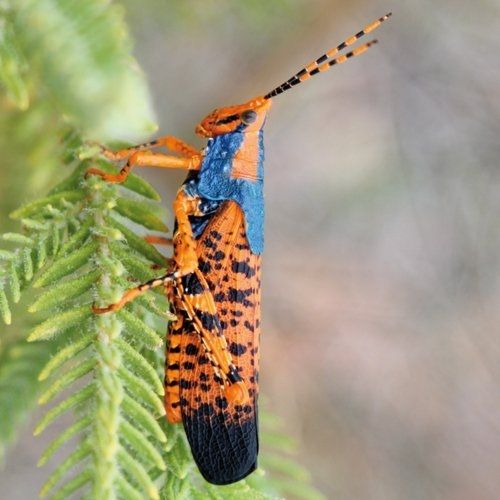
Plants of the Stone Country
Plants growing in the stone country and on the outliers must survive extremely hot, waterless conditions for many months each year. Among the best examples of plants well adapted to these harsh conditions are the resurrection grasses, which dehydrate in the absence of moisture and spring back to life within 24 hours of rain.
Monsoon forests often develop in the cool, moist gorges that dissect the stone country. They are generally dominated by Allosyncarpia, a large, spreading, shady tree restricted to the Kakadu and Arnhem Land region.
More widespread and easily recognisable stone country and outlier plants are spinifex and the sandstone pandanus.
The dominant sandstone escarpment of the Arnhem Land Plateau ranges in height from 30 metres to 300 metres, and includes the rock shelters and outliers of Ubirr and Nourlangie. In some areas the escarpment is eroding by up to one metre every thousand years.
Tidal flats and coast
Kakadu is made up of almost 500 square kilometres of coastal and estuarine areas, mostly lined with mangrove forests. The estuaries and tidal flats are home to an array of plants and animals adapted to living in the oxygen-deficient saline mud. They form important nurseries for many fish including barramundi.
Further inland, these areas are dominated by mangrove swamps and samphire flats, with pockets of monsoon rainforest forming in areas such as Manngarre, where freshwater springs occur.
The shape of the estuaries and tidal flats vary between the wet and dry seasons. During the dry season tidal action deposits silt along the river beds and banks. During the wet season the river beds are eroded by the floodwaters and large quantities of fresh and saline water flow out across the tidal flats, where silt is deposited. Large silt loads are also carried out to sea, with some of the silt being deposited as a nutrient-rich layer on the sea floor, contributing to the muddy waters that characterise Kakadu's coastline.
The dominant habitats are mangrove swamps and samphire flats. Where freshwater springs occur along the coasts and river banks, isolated pockets of coastal monsoon rainforests form, as at Manngarre.
Estuaries and tidal flats can be seen at West Alligator Head and in the lower sections of the South and East Alligator Rivers.
Wildlife of the tidal flats
Many birds live in the estuarine and tidal areas of the park including the chestnut rail, the collared (or mangrove) kingfisher, the broad-billed flycatcher, the black butcherbird, the mangrove gerygone (or warbler), and the red-headed honeyeater. During the wet season egrets, ibis’, herons and cormorants nest in large colonies in the mangrove tree tops.
Mangroves are also used by the black and little red flying foxes which congregate in colonies or camps. Mangrove monitors and estuarine crocodiles often wait below the camps to eat fallen flying foxes.
On the sandy beaches of West Alligator Head and Field Island, flat-back turtles haul themselves out of the water to lay their eggs in darkness. Other animals that are often found in the coastal area are the white-bellied mangrove snake, Darwin and Hardwick's sea snakes, and the dugong (or sea cow), which feeds on seagrass beds.
The shady coastal monsoon pockets offer plenty of vegetation that orange-footed scrubfowl can rake up into large mounds. The birds lay their eggs in the mounds, using the heat from the rotting vegetation to incubate the eggs. The mounds are used by succeeding generations—some mounds in the park are well over 100 years old.
Also living on the forest floor are the colourful rainbow pittas, which can sometimes be heard scratching through the leaf litter for insects. They are also often seen on the walking track to Maguk.
Fruit from the fig trees that grow in the forest provides food for the rarely seen rose-crowned fruit dove. The figbird, oriole and migratory Torres Strait pigeon also eat these figs.
Plants of the tidal flats
Mangroves are common along the banks of tidal creeks and rivers. Some 39 of the 47 Northern Territory species of mangrove occur in Kakadu. Mangroves are important for stabilising the coastline and serve as feeding and breeding grounds for many animals, including fish such as barramundi.
Like other plants growing in estuaries and tidal flats, mangroves must be able to cope with oxygen-deficient soils and periodic inundation by salt water. Mangroves use a range of mechanisms to cope with these conditions. Some species, such as the grey mangrove, have roots projecting through the soil (pneumatophores). Others, such as the spider mangrove, have an amazing raised root system-like the legs of a spider-to help with oxygen intake. A number of mangroves are able to exclude salt through specialised filters in their roots or through salt glands in their leaves.
On the tidal flats behind the mangroves, hardy succulents (samphire), grasses and sedges grow. Isolated pockets of monsoon forest grow along the coast and river banks. These forests contain several impressive trees including the banyan fig (recognisable by its large, spreading aerial roots) and the kapok tree, which has a spiny trunk, large, waxy red flowers and pods full of cotton-like material.
Flood plains and Wetlands
Floodplains undergo dramatic seasonal changes. Following wet season rains, a sea of shallow freshwater spreads over the plains for hundreds of square kilometres. As the floodplains start to dry, waterbirds and crocodiles seek refuge in the remaining wet areas such as Yellow Water.
Nutrient-rich soils carried in the floodwaters add nutrients to the floodplains, which, along with an abundance of water and sunlight, make the floodplains an area of prolific plant and animal life. During the dry season the water recedes into rivers, creeks and isolated waterholes or billabongs.
Wildlife of the Wetlands
The floodplains and wetlands of Kakadu are important refuges and feeding grounds for many Australian waterbirds, especially during the dry season. The populations of some waterbirds that are abundant in Kakadu are largely restricted in Australia to a narrow band along the northern coastline. Typical of these birds are the magpie goose, the green pygmy goose, the Burdekin duck, and the wandering whistling duck.
Other commonly seen and more widespread waterbirds are the jabiru, the comb-crested jacana (or lotus bird), cormorants, darters, egrets, ibises and herons.
Kakadu's wetlands are visited each wet season by about 30 species of migratory birds, such as the little curlew, the snipe and the godwit. The birds' breeding grounds are in the Northern Hemisphere, in places such as Siberia, China and Japan. Each year they leave their breeding grounds at the end of the northern summer to fly south to warmer climates. Most migratory birds visit Kakadu during the wet season. As noted, the wetlands of Kakadu are on the list of Wetlands of International Importance and Australia has entered into agreements with the governments of China and Japan to protect the breeding and summer grounds of migratory birds.
A number of reptiles live on Kakadu's floodplains. Northern snake-necked turtles are perhaps the most frequently seen turtles. They bury themselves in mud as the water dries up at the end of the dry season.
The larger pig-nosed turtles are more secretive. It was Aboriginal rock art paintings of the pig-nosed turtle that first suggested to scientists that these animals occurred in the area. The Arafura file snake is abundant but rarely seen because it lives in billabongs among the roots of the river pandanus. Freshwater and Macleay's water snakes are sometimes seen swimming gracefully through the water. King brown snakes and water pythons are common on the floodplains.
Estuarine or saltwater crocodiles are found in both freshwater and salt water. They are often seen on the Yellow Water and East Alligator River boat cruises. Their nests are usually mounds of mud and rotting vegetation next to permanent water. Nesting occurs during the wet season (between December and April), and about 80 per cent of mature females nest each year, laying about 50 eggs. Generally, at least 75 per cent of the eggs laid fail to hatch because the nest becomes flooded.
The paperbark forests that fringe the floodplains provide ideal nesting sites for wetland birds such as the jabiru, the white-bellied sea eagle, the whistling kite and the green pygmy goose. Paperbark forests are also home to the brush cuckoo, the lemon-bellied flycatcher, the rufous-banded honeyeater, and the restless flycatcher.
When they are in flower paperbarks provide food for nectar-feeding birds such as honeyeaters and lorikeets. Kingfishers such as the blue-winged kookaburra and the forest kingfisher, with its white wing patches, are often seen darting through the paperbark forest. The rainbow bee-eater and several species of flycatcher are also often seen. The mistletoe bird feeds on the berries of the parasitic mistletoe plant on the paperbarks, spreading the plant's seed to other parts of the forest.
Paperbark forests also provide a safe haven for agile wallabies, who must leave the safety of treed areas to drink and graze at the water's edge.
Plants of the Wetlands
Where floodplains are inundated for two to six months a year grasses and sedges such as spike rush occur. Clumps of freshwater mangroves (itchy tree), pandanus and paperbarks are found on slightly higher ground. Herbaceous swamp vegetation dominates areas covered by water for six to nine months a year. A variety of waterlilies, such as the blue, red, yellow and white snowflake, are commonly found in these areas.
The outliers
The outliers are essentially pieces of the Arnhem land plateau that have, through past erosive action, become separated from the plateau complex. They were islands in the ancient seas that once covered much of Kakadu. Nourlangie Rock and Ubirr are good examples of outliers.
Take the first step
A journey of 1000 miles begins with a single click.
Enter your email to get free trip planning advice from Kakadu rangers.

